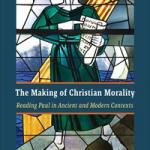Kelly M. Kapic with Justin Borger
The God Who Gives: How the Trinity Shapes the Christian Story, 2nd edition.
Grand Rapids, MI: Zondervan, 2018.
Available at Zondervan and Koorong.
By Dr. Kate Tyler
The God Who Gives is a trinitarian approach to biblical theology, with an extended focus on what it means for humanity to belong to God, and by extension, to take part in the mission of God. Reminiscent in many ways of Kathryn Tanner’s emphasis on God as gift-giver,[1] Kapic is convinced that approaching the biblical narrative through the central idea of divine generosity causes it, and our lives, “to open up before God’s glorious and empowering grace” (p.264).
Kapic tells the Christian story in three movements. Beginning by adeptly grounding the creation narrative in the pre-existent life and love of the Triune God, recognising that creation is a free act which flows from God’s triune being, humanity’s journey from “belonging to bondage” is told, explaining the consequences of the Fall, and its impact on human history, focusing on the story of God’s people throughout the Old Testament. The second movement is the story of redemption; God reclaims creation by giving himself. In this section, discussion on the Son, Spirit, and the kingdomof God alternates between theology and lived experience; for example, ‘The Gift of the Spirit’ is partnered with ‘Experiencing the Gift’, linking a rich exploration of the person and work of the Spirit with the transformative work of the Spirit in shaping us into the likeness of Christ and adopting us into the family of God.
The third movement explores what it looks like for Christians to live out the Christian life in imitating Jesus’ willingness to go to the Cross, the significance of the Resurrection, and what it means to think about the Church in the light of the Trinity and God’s self-giving. Kapic rightly observes that “to believe in God is to believe in his church, to enter Yahweh’s community of peace and sacrificial love and to reach out from it” (p.236). The tension between faithfulness and fruitfulness is nicely balanced, recognising that “God’s generosity does not annihilate our dignity and significance; rather, it liberates our actions as he invites us to participate in the movement of his divine generosity” (p.189).
This is a well-written work, full of rich theological insight yet well pitched to connect with both the head and the heart. Drawing on an excellent range of scholars, Kapic also consistently engages with Scripture to illuminate his more systematic and practical points. I appreciated the fulsomeness with which he cited key Scriptures throughout, rather than just alluding to biblical content in passing. Kapic also interacts well with questions such as ‘Why does God create?’ and ‘Why is the cross necessary,’ taking care to ground his answers deeply in the doctrine of the Trinity. Each chapter helpfully explores a number of sub-themes, which are easy to navigate thanks to the well-presented formatting of the book. This is a read that would be relevant for laypeople and scholars alike.
[1] See Kathryn Tanner, Jesus, Humanity and the Trinity: A Brief Systematic Theology (Edinburgh: T&T Clark, 1991).
Dr. Kate Tyler is Lecturer at Bishopdale Theological College.












